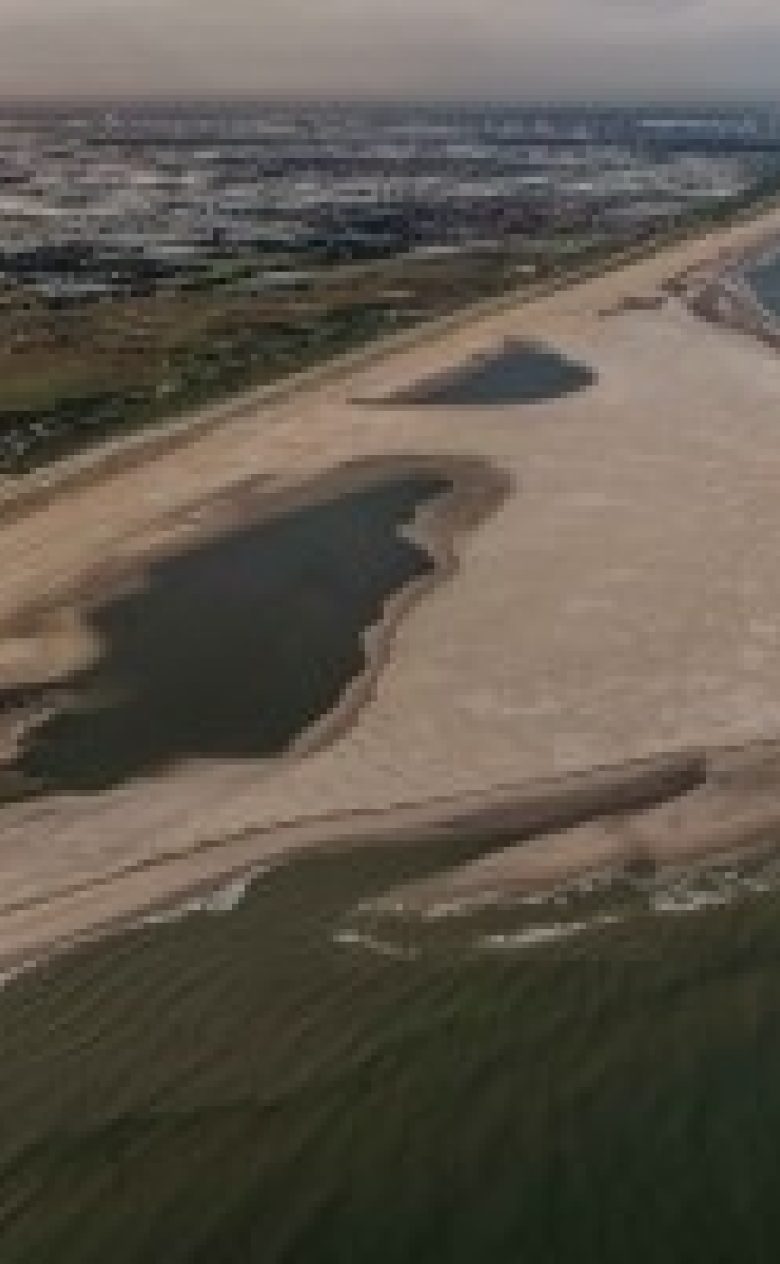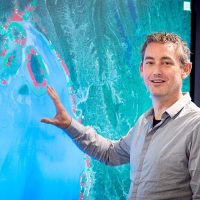Sand Motor
Large parts of the Dutch coast are eroding. To safeguard the hinterland, Rijkswaterstaat nourishes the coast frequently. To explore alternative solutions for depositing large amount of sand along the shore, a pilot project was developed called the Sand Motor.

Over 10 years of Sand Motor
The evaluation of ten years of the Sand Motor shows that the innovative Sand Motor pilot is a success. The peninsula made of 21.5 million cubic metres of sand was created in 2011 on the coast near Kijkduin using the Building with Nature principle. The aim of the pilot project was to determine whether the wind and currents would spread the sand along the coast and towards the dunes, strengthening the coast in the long term and creating a dynamic nature and leisure area. That goal has been achieved. The evaluation shows that the coast is wider, that the dunes are growing well and that leisure visitors appreciate the area. The Sand Motor is also contributing to knowledge development about coastal management and maintenance, and inspiring other coastal protection projects worldwide.
Thanks to the Sand Motor pilot we can estimate the effects of future large-scale coastal measures. At Deltares we see this as a very necessary preparation given the challenges we face as a result of climate change
Ben Huisman, coastal expert
Long-term coastal protection
The expectation beforehand was that the Sand Motor would widen the dunes and therefore improve coastal protection. After a slow start, dune formation in recent years is progressing well. That is particularly clear to see on the southern part of the Sand Motor, where dunes up to three meters high have formed on the beach. The existing row of dunes near the Sand Motor is also wider now. Dune formation is expected to increase further in the coming years.
Nature and leisure
The Sand Motor is a valuable area in terms of landscape and dynamics. There is a more diverse population of benthic animals than on a normal stretch of beach because the Sand Motor has a wider range of habitats. That makes the area more appealing for coastal birds in the area. Counts have shown there are more of them in terms of both numbers and species. In particular, the presence of the Cormorant, the Sandwich Tern, the Common Tern and the Great Black-Backed Gull are of added value because they are less common elsewhere. It should be pointed out that the Sand Motor appears to be less suitable for breeding birds because of the presence of leisure visitors.
The Sand Motor is particularly appealing for kite surfers. Walkers and runners also come here in large numbers. The Sand Motor is less popular with bathers because of the large distance to the water’s edge. Visitors to the Sand Motor award the area an average of 8 out of 10 according to research by Wageningen University in 2020. They appreciate the clean beach, the landscape, and the calm and space.
Knowledge and innovation
The Sand Motor has proved to be a breeding ground for broad-based knowledge building about innovative, sandy solutions for coastal management and maintenance. In the Netherlands, the knowledge acquired from the Sand Motor at Kijkduin was used for the construction of the Hondsbossche Duinen and for the pilot sand nourishment project in the Ameland tidal inlet. The knowledge has also been used outside the Netherlands. In the United Kingdom, for example, a small Sand Motor was created near Bacton (in the county of Norfolk) in 2018.
Bas Huisman: “The Sand Motor has created an exceptionally dynamic coastal area, where sand is redistributed to the dunes and surrounding coast. Sand also spreads on regular sandy coastal sections, but the changes are much more distinct at the Sand Motor. The unique dynamics at the Sand Motor have also led to insights into the natural coastal processes that would otherwise be immeasurable. Deltares has coordinated the measurement programme, in which we captured both the dynamics of the physical system and ecology in exceptional detail. Based on this, we learned how sand spreads along the coast, how new vegetation and dunes grow, where benthic life develops and how we can combine recreation and nature. Thanks to the Sand Motor pilot we can estimate the effects of future large-scale coastal measures. At Deltares we see this as a very necessary preparation given the challenges we face as a result of climate change”.
How the Sand Motor began
In 2011, Rijkswaterstaat and the Provincial Authority of South Holland agreed to construct a hook-shaped peninsula of about 21.5 million m3 of sand. It protrudes 1 km into the sea and covers 2 km alongshore. Trailing suction hopper dredgers picked up the sand ten kilometres off the coast and deposited it nearshore. The Sand Motor is a great example of Building with Nature.
A traditional design of a sandy nourishment has the primary objective of shoreline maintenance using a medium volume of sand (2-5 million m3). The lifespan of the nourishment is typically in the order of 5 years. This means that every 5 years the nourishment has to be redone, resulting in a frequent disturbance of the ecosystem.
In the Sand Motor Pilot project, a concentrated mega-nourishment was constructed, rising up to 5 meters above mean sea level. By making use of natural processes to redistribute the sand, this innovative approach aims to limit the disturbance of local ecosystems, while also providing new areas for nature and more types of recreation.
Rijkswaterstaat assigned Deltares to conduct comprehensive field measurements for a period of at least five years. The field data has been analysed by Deltares together with Imares and Witteveen & Bos focusing on coastal and swimmer safety, dune formation and the ecological impact of the Sand Engine and its surroundings.
Deltares is also actively involved in the scientific research projects NEMO and NatureCoast at the TU Delft. Main focus is on the development of integral modelling tools on coastal morphology, aeolian transport and the fresh groundwater resources at the Sand Engine.
The future of the Sand Motor
The Sand Motor will continue to develop in the years to come. The more sand spreads towards the dunes and beach, the less will remain of the original sandbank. We will continue to monitor and follow this process. After all, the dynamics mean that the Sand Motor may also produce new insights in the future.
The results of ten years of the Sand Motor show that a sand motor concept can play a genuine role in the management and maintenance of the coast. In the Sea Level Rise knowledge programme, the Ministry of Infrastructure and Water Management is investigating other locations where the concept could be used.
Partners
The Sand Motor is a pilot project of Rijkswaterstaat and the Province of South Holland in collaboration with research institutes and universities, including Deltares, Wageningen Marine Research and Delft University of Technology.
You have not yet indicated whether you want to accept or reject cookies. This means that this element cannot be displayed.
Or go directly to:


